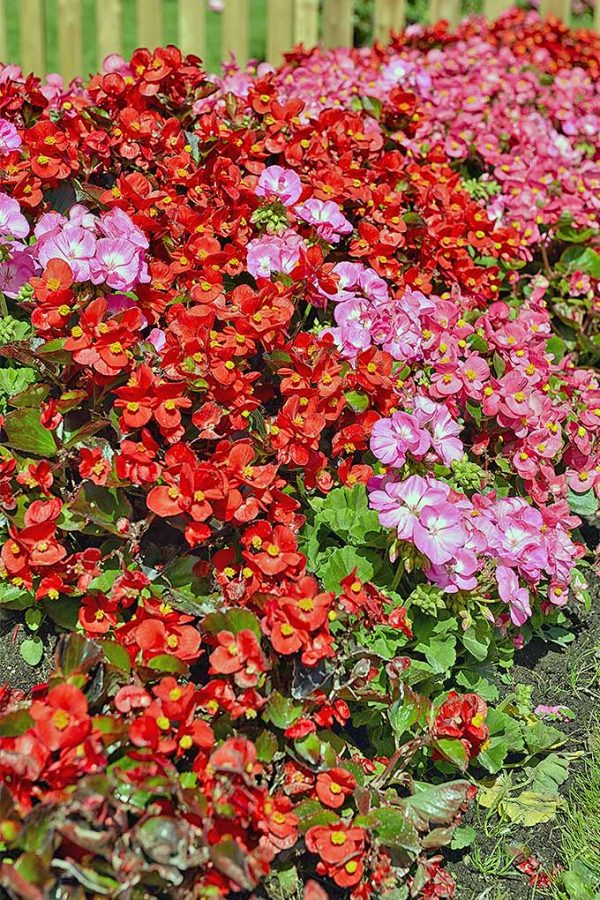

There are many varieties and mixes of wax begonias available for sale in spring. On the other extreme, wax begonias won't flower strongly if planted in deep shade. They grow best with cooler air temperatures. Newer varieties, such as 'Whopper', are more sun tolerant, but under warm summer conditions, too much sun can cause the leaves to burn and the plants to suffer.

Wax or fibrous begonias are best grown in annual flower gardens that get at least some afternoon shade. Some of these will creep along and spill over a pot edge. They are grown for their showy leaves more than their small flowers. Rex and other rhizomatous begonias are mostly grown as houseplants, or brought out to a deck or shady porch in a container, as soon as summer hits. The tubers are usually dug and stored indoors for winter. They bloom in colors from white to deep red with many bicolored varieties, from late summer until fall. These grow from underground tubers into upright or trailing plants with stunning clusters of flowers. Tuberous begonias are probably the second-most popular outdoor begonia for gardeners. Although they are perennial in a warmer climate, most gardeners treat them as annual flowers. They are grown as bedding plants in spring, similar to marigolds, impatiens and petunias. These plants have white, red, or pink colored flowers on green or red leaf varieties. Fibrous, rooted begonias or wax begonias are probably the most common to gardeners. The small stature of Rex begonias makes them ideal as terrarium plants and maintaining them this way reduces watering chores.There are more than 1000 species of begonias that offer attractive leaves and flowers for the outdoor and indoor plant enthusiast alike. The moody 'Red Kiss' could stand in for roses as a romantic gift, and its lusty colors are much more enduring than any cut flower arrangement. 'Pink Charming' and 'Duarten' suggest a stained glass effect that comes from rich veining and stippling. Varieties such as 'Fairy' and 'Silver Queen' sport metallic leaves accented with green, purple, or splashes of red. The foliage delivers a trifecta of beauty, with outstanding colors, foliage, and textures that thrive in ordinary windowsill conditions. Their main appeal is the interesting foliage rather than the flowers. The rex begonias are a vast subcategory of rhizomatous begonias, and they are most commonly grown as houseplants rather than garden plants. They are also most commonly used as houseplants but are a little more finicky than most rhizomatous types. Rex: This is a subcategory of rhizomatous begonias with the showiest foliage of all begonias.They are grown mostly for their interesting foliage and are more often used as houseplants than as garden plants. Rhizomatous: These begonias have fleshy roots and stems creeping along the surface of the soil.They have foliage similar to tuberous begonias but produce rather small pink or white flowers. They are hardy to zones 6-7 and are commonly grown as a perennial in southern gardens. Hardy begonias: These types belong to the species Begonia grandis.This type is popular both for garden planting and for containers. The tubers are often planted as annuals each year, or they can be dug up and stored indoors for the winter. They have a fleshy, round tuberous root like a potato and generally bloom in mid-summer through fall. Tuberous: This group has the most spectacular flowers, large blooms in neon-like shades of pink, yellow, orange, red, or white.Potted plants may continue blooming if you bring them indoors and place them in a bright window through the winter. The flowers are also fairly small, about 1 1/2 inches. The leaves tend to be round and waxy, and relatively small. Fibrous-rooted: This group includes plants described as wax begonias, cane begonias, dragon-wing ( angel-wing) begonias, and other types, all of which have standard root balls with thin roots.However, as noted below some begonia varieties might tolerate more sun than others.īegonias can be categorized a number of ways, but a useful method for gardeners is by root structure: Instead, place them in filtered light, such as beneath high, thin tree canopies. The Spruce Home Improvement Review Boardīegonias need some sunlight, but they don't do well if that sunlight is harsh and direct.


 0 kommentar(er)
0 kommentar(er)
